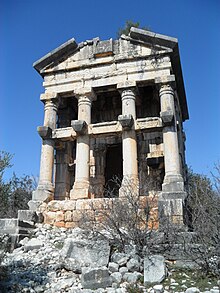Mezgitkale
This is an old revision of this page, as edited by Monkbot (talk | contribs) at 16:46, 5 January 2020 (→History: Task 15: language icon template(s) replaced (1×);). The present address (URL) is a permanent link to this revision, which may differ significantly from the current revision.
 | |
| Alternative name | Korkusuz kral mezarı (Mausoleum of fearless king) |
|---|---|
| Location | Mersin Province, Turkey |
| Region | Cilicia Trachea |
| Coordinates | 36°28′2″N 34°1′37″E / 36.46722°N 34.02694°E / 36.46722; 34.02694 |
| Type | Mausoleum |
| Site notes | |
| Condition | In ruins |
Mezgitkale is a 2nd- or 3rd-century mausoleum in Mersin Province of Turkey.
Geography
Mezgitkale (also known as Korkusuz Kral Mezarı “Mausoleum of fearless king” ) is a small mousaleum near Öztürkmenli village in Silifke district. It is situated in the 500 metres (1,600 ft) high plateau to the south of Toros Mountains. It is accessible from Atakent on the Mediterranean shore. Distance to Silifke is 27 kilometres (17 mi) and to Mersin is 80 kilometres (50 mi)
History
Although the Turkish suffix -kale means fort, this building is actually a mausoleum. Also, contarary to popular belief it is not a mausoleum of a king. It was built by an eminent Roman citizen (probably a land owner) for his family. The building was used as a tomb for about two centuries.[1] Then it was abandoned during the Byzantine era. During Ottoman era, the building was used as a house and a furnace was added to the original building.
Technical details
The dimensions of the square building are 7.8 x 7.8 m2 (25.6 x 25.6 ft2). The entrance with four Corinth type columns and corbels is at the south. On the north wall there are reliefs of a shield, a sword and two scorpions. On the west wall there is a relief (now partially damaged) of a phallus probably dedicated to Priapos. Next to the moselaum, there is a stone carved cistern with dimensions 5 x 20 x 8 m3 ( 16.4 x 65 x 26 ft3).[1] According to Ministry of Culture and Tourism, there was also an olive oil workshop.[2]
References
- ^ a b Silifke governor’s page (in Turkish) Archived 2012-02-26 at the Wayback Machine
- ^ Haydar Dönmez-Candaş Keskin: Kültür ve Turizm Bakanlığı, 27. Araştırma Sonuçları Cilt 3 sf. 101

